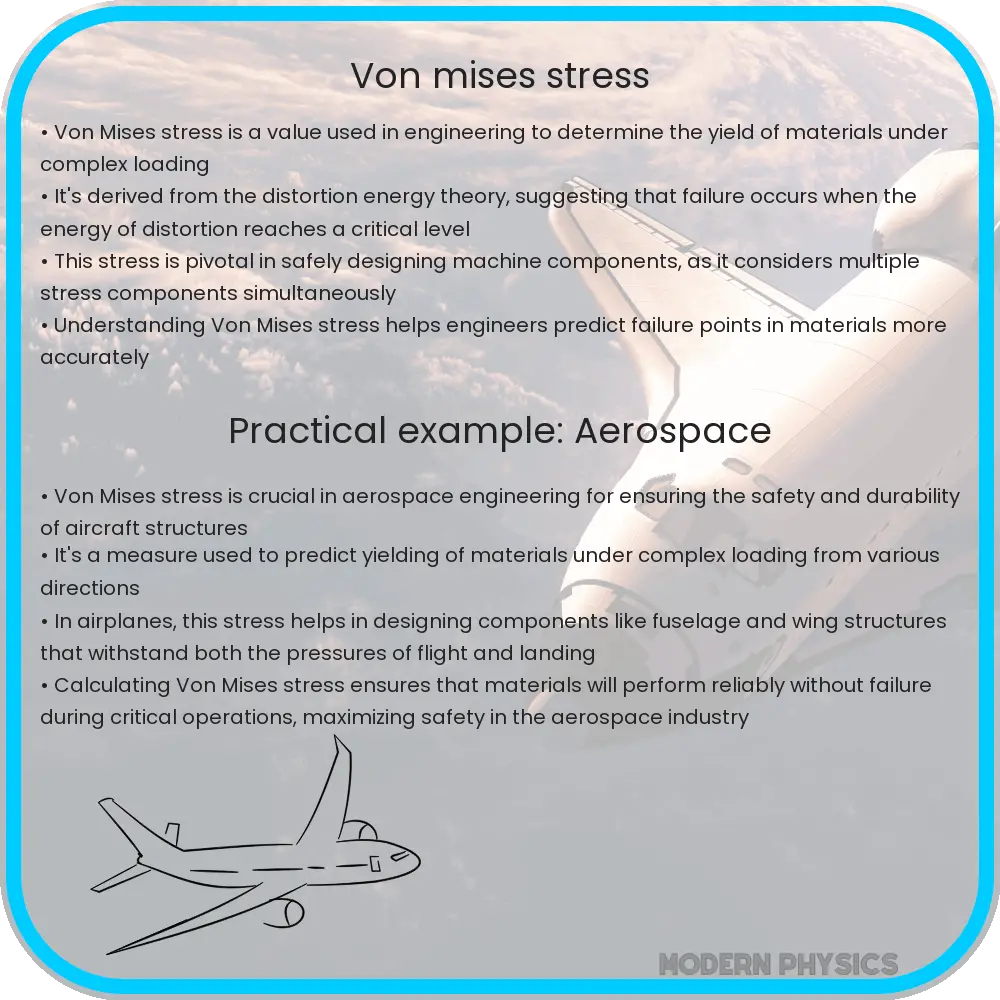Explore the essentials of Von Mises Stress in material science and engineering, its analysis, yield criteria, and diverse applications.

Von Mises Stress: Understanding the Fundamentals
The concept of Von Mises Stress plays a critical role in the field of material science and engineering, particularly in understanding how materials deform and fail under various types of loading. It is a theoretical construct used to predict yielding of materials under any loading condition from the known yield strength of the material in simple tension.
Analysis of Von Mises Stress
At its core, Von Mises Stress, also known as the equivalent or octahedral shear stress, is a scalar stress value used to estimate the yield of materials. It is derived from the distortion energy theory, which states that yielding occurs when the distortion energy per unit volume due to the applied stresses reaches a critical value, the same as that at the yield point in a uniaxial tensile test.
The mathematical representation of Von Mises Stress, \(\sigma_{vm}\), is given by:
\[\sigma_{vm} = \sqrt{\frac{1}{2}[(\sigma_x – \sigma_y)^2 + (\sigma_y – \sigma_z)^2 + (\sigma_z – \sigma_x)^2]}\]
where \(\sigma_x\), \(\sigma_y\), and \(\sigma_z\) are the principal stresses in three orthogonal directions.
Yield Criterion in Von Mises Stress
The Von Mises Yield Criterion, also known as the Von Mises-Hencky criterion, is a formula used to predict the yielding of ductile materials. According to this criterion, yielding begins when the Von Mises Stress reaches the material’s yield strength in simple tension, denoted as \(\sigma_y\). This criterion is particularly useful for ductile materials like steel and aluminum, which show significant plastic deformation before failure.
Applications of Von Mises Stress
Von Mises Stress finds extensive application in design and analysis in mechanical engineering, particularly in the fields of pressure vessel design, fatigue analysis, and structural engineering. It helps engineers to predict the failure of materials and structures under complex loading conditions, ensuring safety and reliability. This concept is integral in finite element analysis (FEA), where it is used to analyze stress distribution in complex geometries and loading scenarios.
In conclusion, the Von Mises Stress is a fundamental concept in material science and engineering, aiding in the design and analysis of materials and structures under various loading conditions. Its theoretical and practical applications make it an indispensable tool in the realm of mechanical engineering and materials science.
Advanced Considerations in Von Mises Stress Analysis
While Von Mises Stress is a powerful tool in material analysis, its application requires understanding its limitations. It is ideal for ductile materials but less applicable for brittle materials, where the maximum normal stress criterion is more suitable. Additionally, Von Mises Stress does not directly account for hydrostatic stress components, which can be significant in some applications like high-pressure vessel designs.
Incorporating Von Mises Stress in Engineering Design
Engineers incorporate the Von Mises Stress analysis in designing components to ensure they can withstand anticipated stress without yielding. In computer-aided engineering, software tools use the Von Mises criterion to highlight areas of potential material failure, allowing for optimization of designs for weight, cost, and safety.
Comparison with Other Yield Criteria
Comparatively, the Tresca yield criterion, another popular yield criterion, is sometimes used as an alternative to Von Mises. However, Von Mises is often preferred due to its more accurate predictions in most practical cases and its ease of implementation in computational models.
Von Mises Stress in Education and Research
Academically, the study of Von Mises Stress is integral in mechanical and materials engineering curricula. It is a cornerstone in understanding material deformation and failure theories. Ongoing research continues to refine the applications of Von Mises Stress, particularly in complex materials and advanced manufacturing technologies.
Conclusion
The Von Mises Stress is a cornerstone in the field of material science and engineering. Its role in predicting the yield and failure of materials under complex stress states has revolutionized design and analysis in various engineering disciplines. While it is predominantly applicable to ductile materials, its integration into computational tools has greatly enhanced the efficiency and reliability of engineering designs. As materials and manufacturing technologies evolve, the principles of Von Mises Stress continue to be relevant, guiding engineers and researchers in the quest for safer, more efficient, and innovative solutions in the engineering world.
